Nestled on the stunning Dalmatian Coast of Croatia, Trogir is a UNESCO World Heritage Site that captivates visitors with its rich history, medieval charm, and architectural treasures. Located in the heart of Central Dalmatia, Trogir is strategically positioned between the cities of Split and Šibenik, making it a cultural and historical gem in the region.
Where is Trogir located
Trogir is situated on a small island between the mainland and the larger Čiovo Island, connected by bridges. Its geographical location at the crossroads of land and sea routes has played a crucial role in its development and historical significance. The town is conveniently located just 27 kilometers west of Split and approximately 60 kilometers southeast of Šibenik.
Top 14 Things to do and see in Trogir
Trogir’s downtown is a treasure trove of historical and architectural wonders, offering a delightful journey through time. Here are some must-visit sights:
1. Trogir Old Town , Best place to start
The heart of town is its beautifully preserved Old Town, a maze of narrow cobblestone streets, charming squares, and historic buildings that reflect various architectural styles, including Romanesque, Gothic, Renaissance, and Baroque.
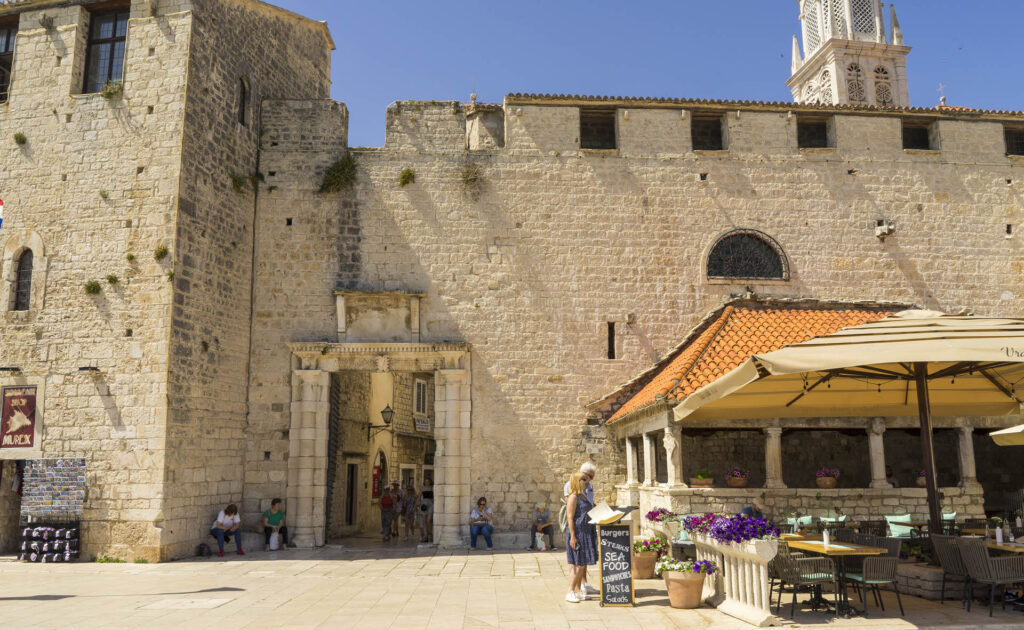
2. Kamerlengo Fortress
Overlooking the town, this fortress is a symbol of Venetian influence. It offers panoramic views of the surroundings.
History: Built in the 15th century by the Republic of Venice, Kamerlengo Fortress served both as a defensive stronghold and a symbol of Venetian power in the region. Its strategic location allowed it to control access to the town and safeguard against potential invaders. Over the years, the fortress underwent various modifications, adapting to the evolving needs of the time.
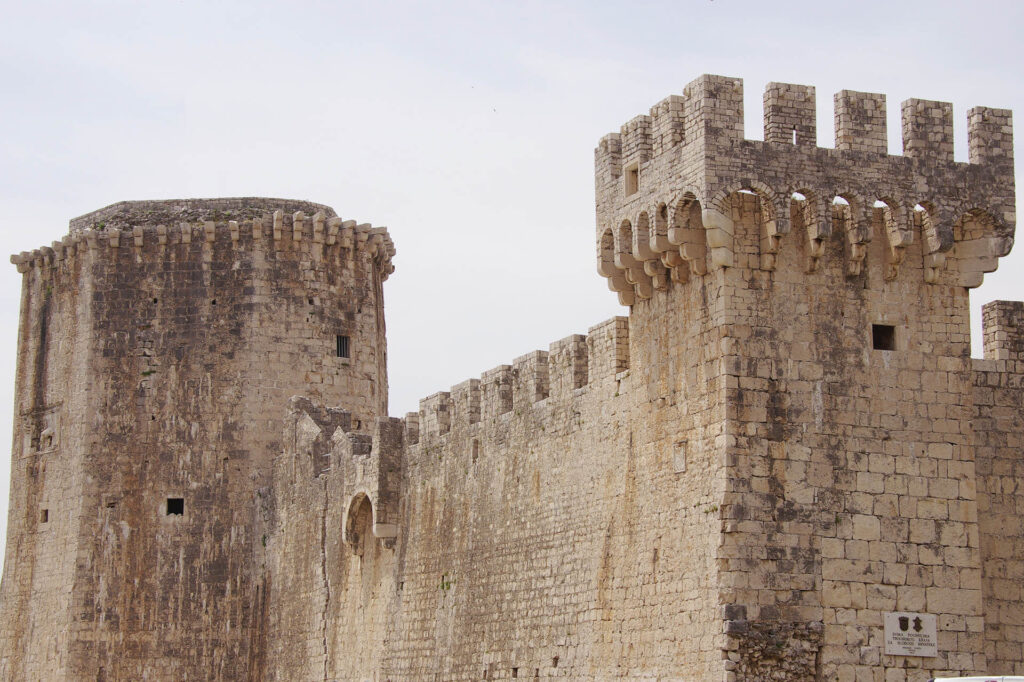
Venetian Military Might: Commissioned by the Venetian authorities, Kamerlengo Fortress was designed to safeguard city against external threats. Its robust stone walls and formidable towers reflect the military prowess of the Venetian Republic during a period of heightened maritime tensions.
Exploration Tips:
Panoramic Views: Climb to the top of Kamerlengo Fortress to savor breathtaking panoramic views. The vantage points offer splendid vistas of Trogir’s red-roofed old town, the azure Adriatic waters, and nearby islands.
Cultural Events: During the summer months, the fortress hosts local events, offering engaging performances and exhibitions within its historic walls. The juxtaposition of ancient stone walls and contemporary cultural expressions adds a unique dimension to the visitor experience.
Historical Insights: Engage with informational guided tours to delve into the historical narratives of Kamerlengo Fortress.
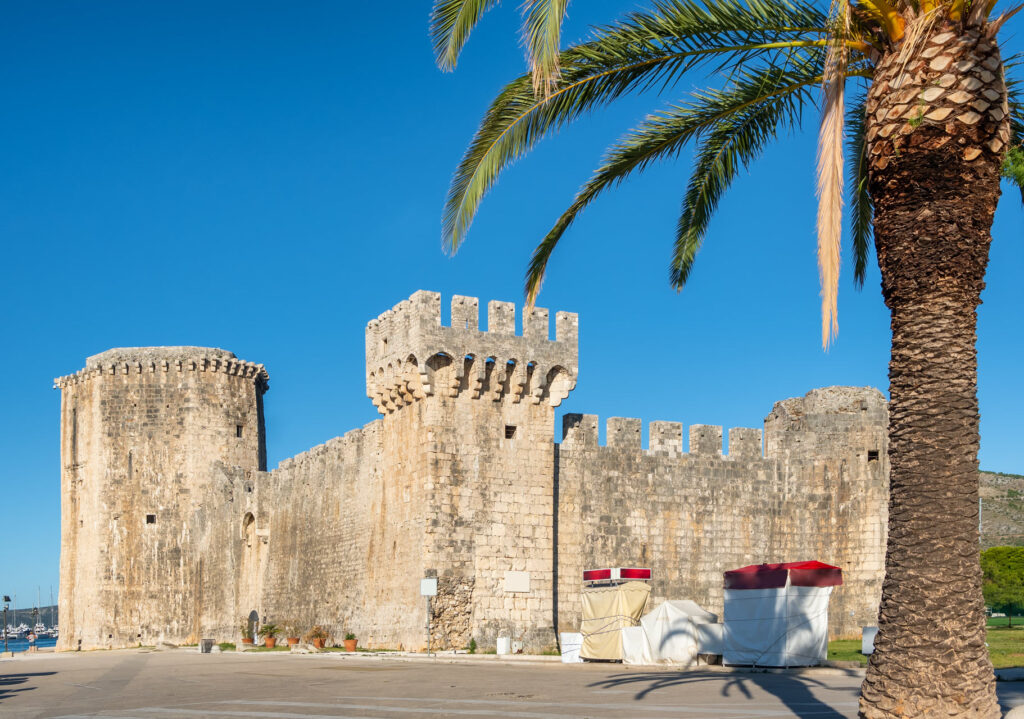
3. North and South Town Gates of Trogir
The North and South Town Gates stand as silent sentinels, guarding the ancient city and offering a tangible link to its medieval past. Each gate carries with it a history steeped in strategic significance, embodying both the practicalities of defense and the symbolic importance of entry and exit. The North and South Town Gates were pivotal in the town’s defense strategy, serving as barriers against potential attackers.
South Town Gate: Situated at the southern end of Trogir, the South Town Gate, or “Porta Sponza,” serves as the gateway to the town from the seafront. Dating back to the 15th century, this gate was designed not only for defense but also to facilitate trade and maritime activities. During the medieval period, coastal towns faced the constant threat of invasion.
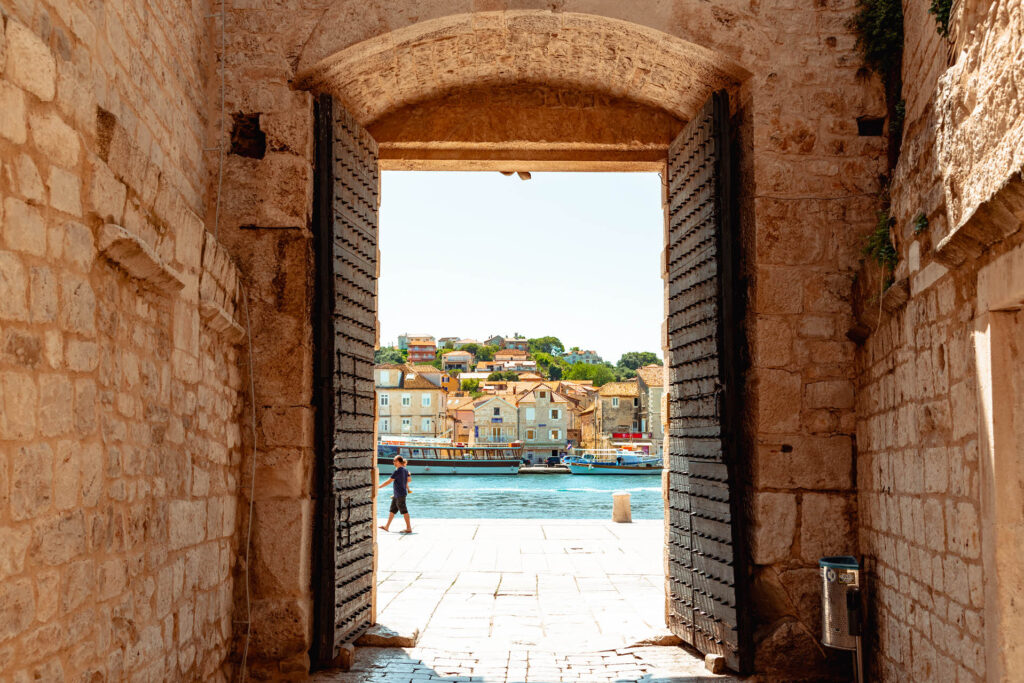
North Town Gate: Located at the northern entrance of the old town, the North Town Gate, also known as “Porta Macurella,” was a vital component of Trogir’s defensive fortifications. Constructed during the 17th century, this gate was strategically positioned to control access to the town from the mainland.
Beyond their practical functions, the gates held symbolic importance. Passing through them was akin to entering a different realm, a sentiment that resonates even today as visitors step into town historical heart.
Architecture: Both gates showcase elements of Venetian influence in their design, showcasing the town’s rich history. Architectural details such as arches, stone carvings, and defensive mechanisms speak to the craftsmanship of the builders and the era in which they were erected.
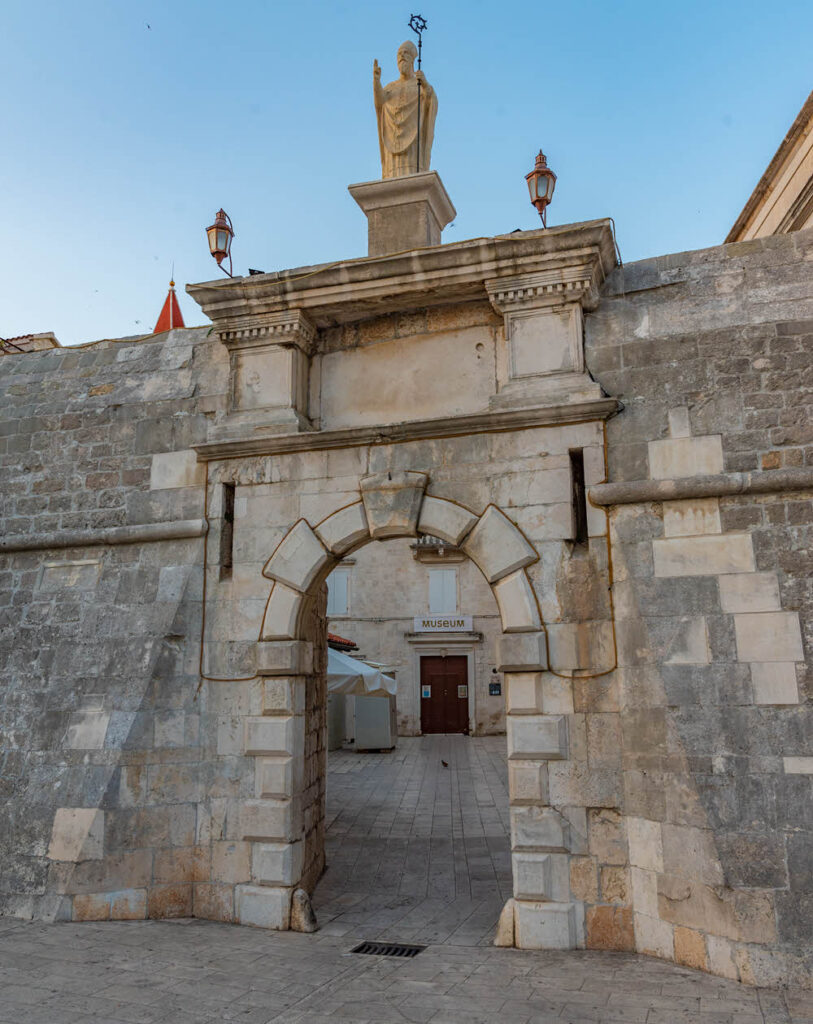
Visiting Today: While the need for defense has long faded, the North and South Town Gates continue to stand proud, inviting modern-day visitors to traverse the same paths as traders, sailors, and defenders did centuries ago. As you pass through these portals, envision the bustling life and strategic considerations that once unfolded around them, and appreciate how these gates remain integral to Trogir’s narrative of resilience and continuity.
4. Trogir Cathedral of St. Lawrence (Katedrala sv. Lovre)
A masterpiece of medieval architecture, the cathedral showcases intricate carvings and sculptures. This imposing structure, recognized as a UNESCO World Heritage Site, is a harmonious blend of Romanesque and Gothic styles, showcasing the artistic brilliance of medieval craftsmanship.
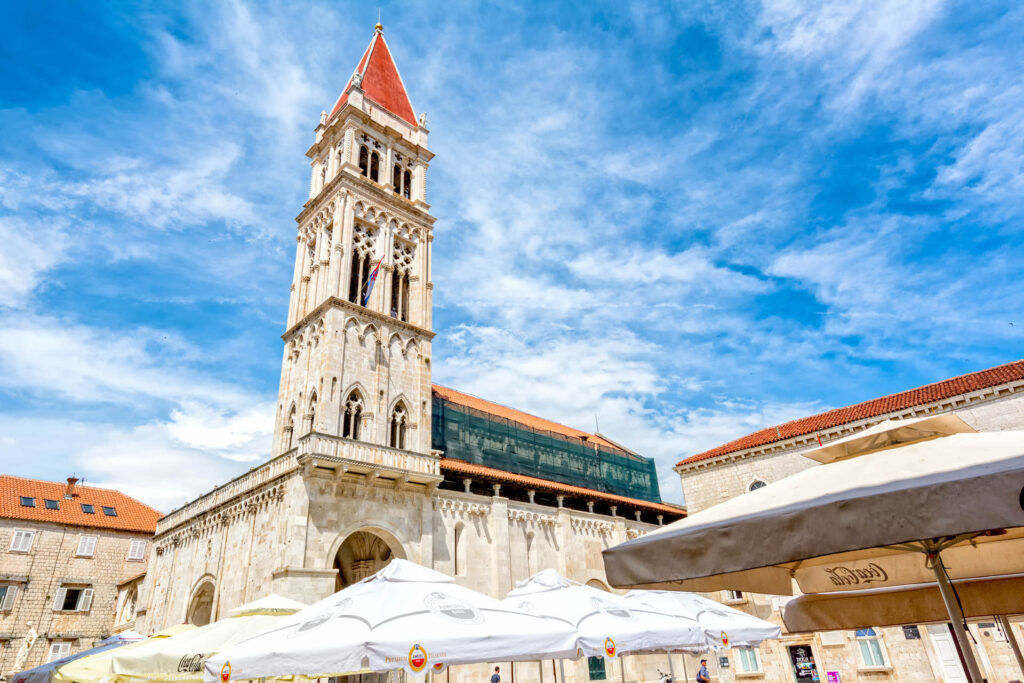
The cathedral’s main entrance is adorned with the Radovan Portal, a magnum opus crafted by the skilled hands of the Croatian medieval sculptor Radovan. Radovan was a Croatian sculptor and architect from the 13th century, resided in Trogir. Often known as “Master Radovan” in Croatian, he remains a mysterious figure in art history, with scant information available about his personality and career. The intricately carved portal depicts scenes from the Bible, including the Last Judgment, with remarkable detail and precision.
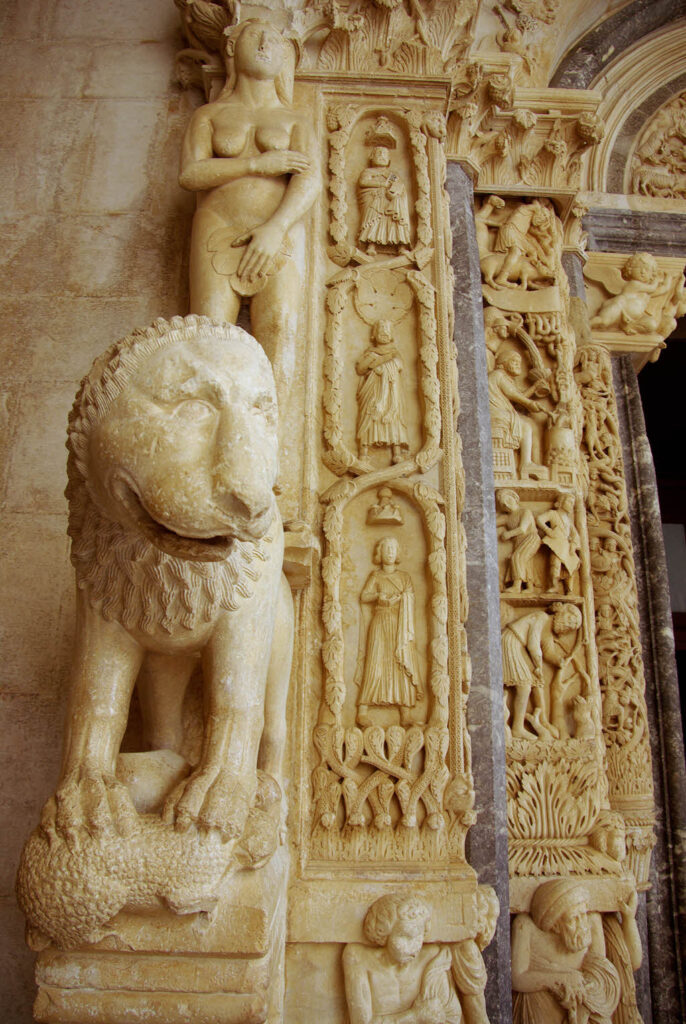
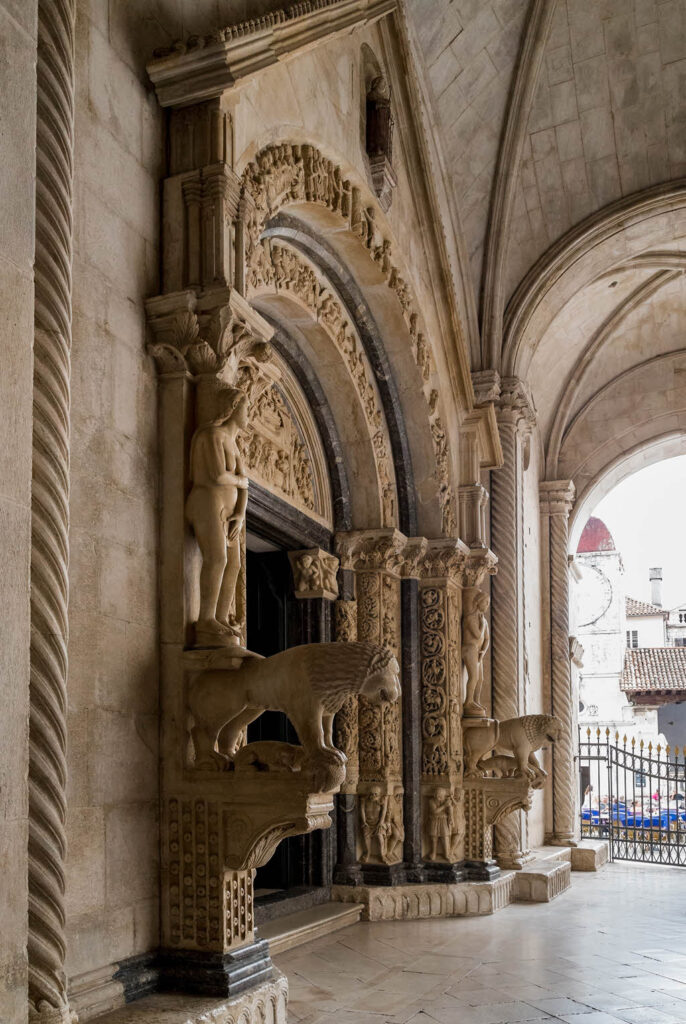
Architecture: The architecture of Kamerlengo Fortress reflects the Venetian military style of the Renaissance period. Robust stone walls, sturdy towers, and a strategically designed layout speak to the fortress’s defensive purpose. Visitors can explore the interior, climb the towers, and enjoy panoramic views of Trogir and the Adriatic Sea.
Visiting Today: Today, Kamerlengo Fortress stands as a popular tourist attraction, drawing history enthusiasts and curious travelers alike. The well-preserved fortress offers a glimpse into Trogir’s rich past and provides a captivating backdrop for cultural events and festivals held within its walls. Exploring Kamerlengo Fortress allows visitors to not only appreciate its architectural significance but also to immerse themselves in the stories and legends that have shaped town’s history. Whether admired for its historical importance, architectural grandeur, or mythical tales, Kamerlengo Fortress remains an integral part of city’s cultural tapestry.
5. St. Mark’s Fortress
The St. Mark Tower stands in the northwest section of Trogir’s historic district. Constructed in the 15th century by the Venetian Republic to withstand cannon fire during the era of Turkish invasions, this circular tower was strategically designed for defense. Originally, it faced inland and was seamlessly integrated into the city walls, forming a cohesive structure with the Kamerlengo Fortress.
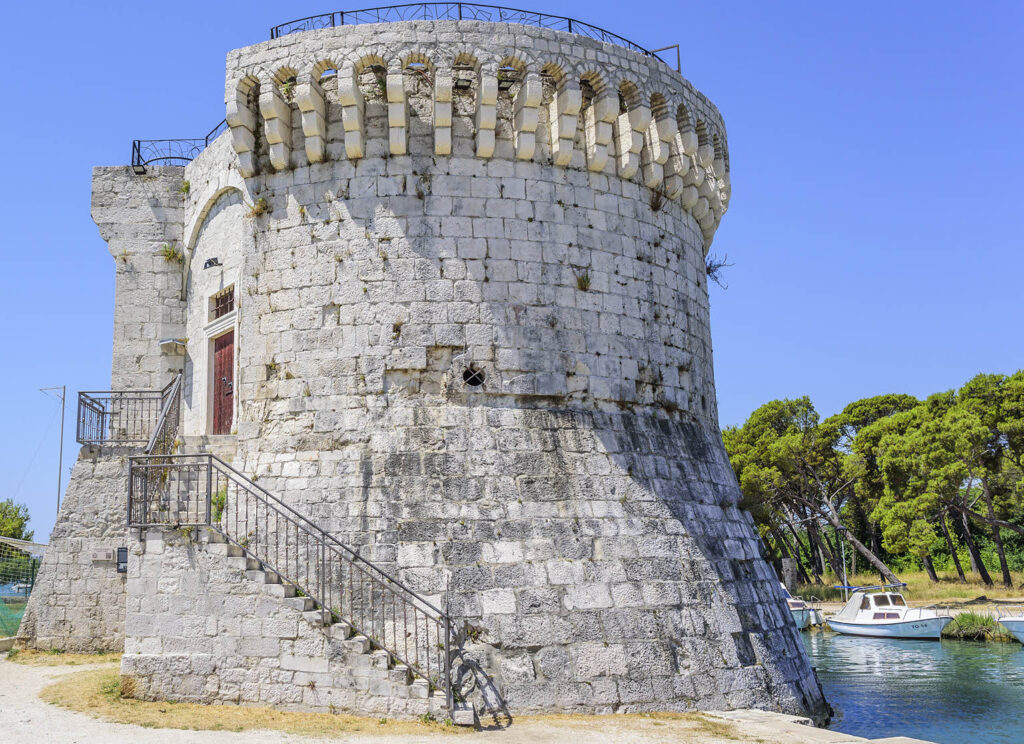
6. Trogir Town Loggia
The Town Loggia, known locally as “Gradska loža,” is an architectural gem situated in the heart of Trogir’s historic center. Dating back to the Renaissance period, this building serves as both a historical landmark and a symbol of the town’s communal and social life. The Town Loggia showcases characteristic elements of Renaissance architecture, featuring balanced proportions, graceful arches, and meticulous detailing.
Historical Significance:
Civic Gatherings: Throughout history, the Town Loggia played a central role as a venue for civic gatherings, official announcements, and important town events. It was a place where the local community converged for various purposes.
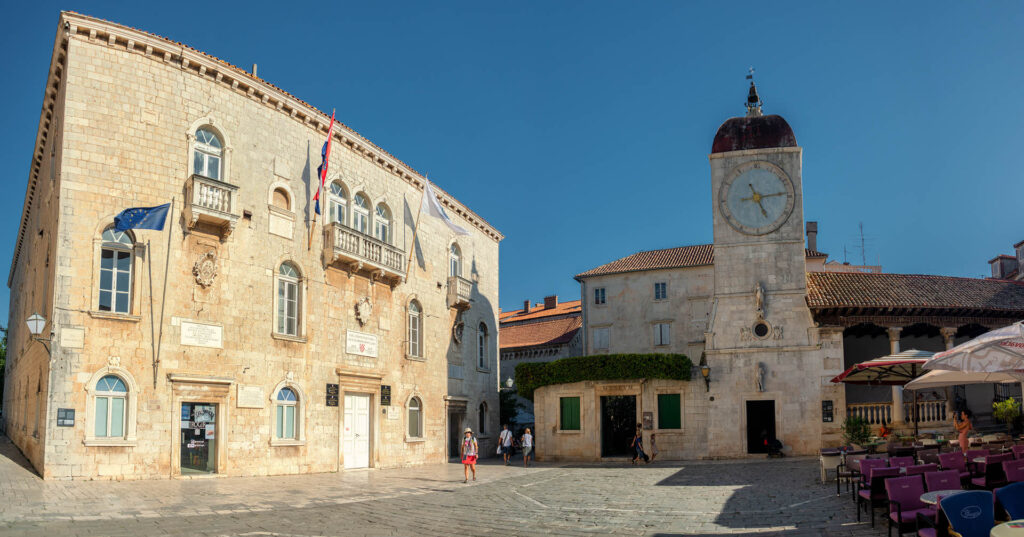
Cultural Events: Today, the Town Loggia continues to be a cultural focal point, hosting exhibitions, cultural events, and occasional gatherings. It remains a space where the town’s vibrant life intersects with its historical legacy.
Architectural Landmark: Beyond its functional aspects, the Loggia stands as an architectural landmark that contributes to the overall charm of town’s historic center.
Symbol of Governance: As a significant civic structure, the Loggia symbolized the governance of Trogir.
Important announcements and proclamations were made from this site.
Visiting Tips: The strategic location of the Loggia offers an excellent vantage point for observing the dynamics of the square and the surrounding architectural treasures.
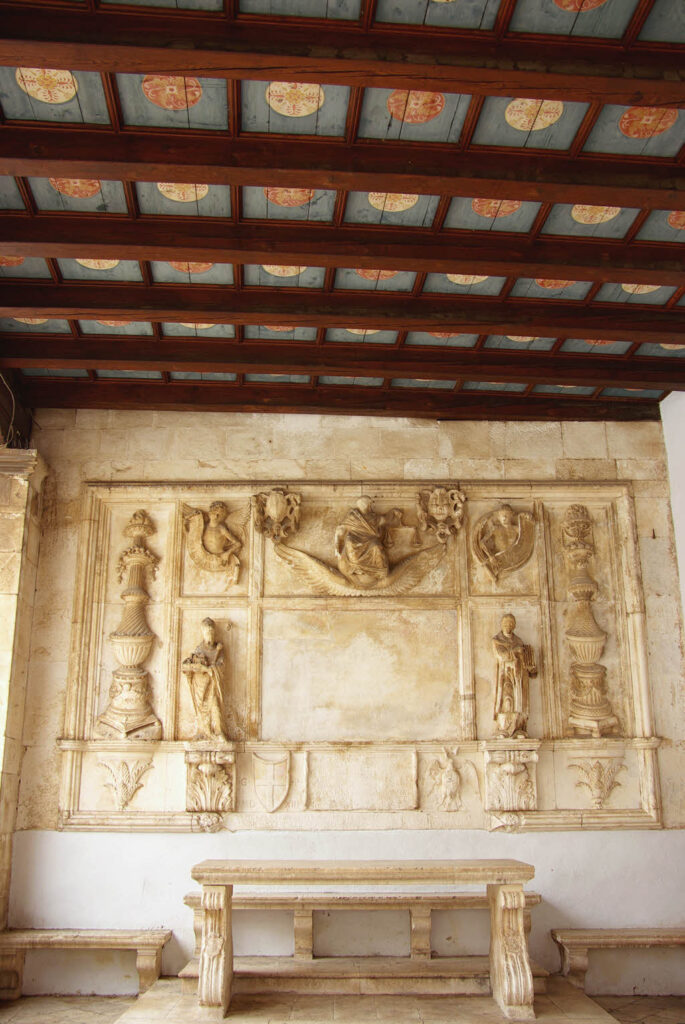
7. Trogir Waterfront (Riva)
The Trogir waterfront, commonly referred to as the “Riva,” is a picturesque promenade that unfolds along the edge of the historic town, offering enchanting views of the Adriatic Sea. Lined with vibrant cafes, restaurants, and charming shops, the Riva is a lively hub where locals and visitors alike come together to savor the coastal ambience.
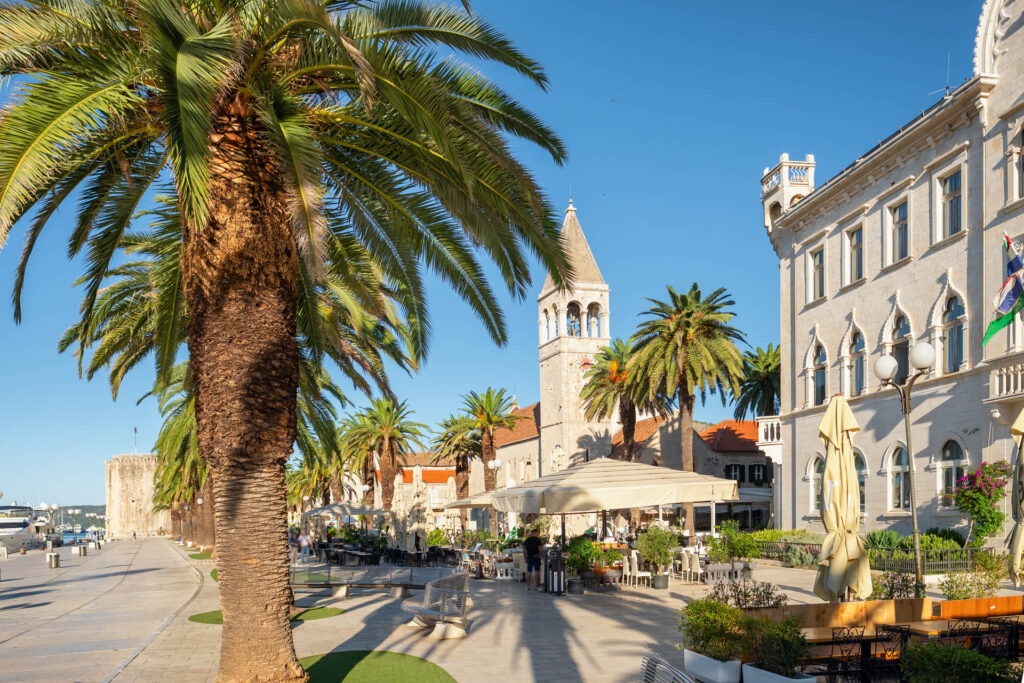
Seaside Promenade: The Riva extends along the waterfront, providing a leisurely pathway for strolling and enjoying the refreshing sea breeze. Its well-maintained promenade is adorned with palm trees, inviting benches, and occasional open spaces for relaxation.
Historical Charm: Flanked by historic buildings and Venetian-inspired architecture, the Riva reflects the town’s rich heritage. The blend of pastel-colored facades and cobblestone streets creates an idyllic setting, transporting visitors to a bygone era.
Quaint Cafes and Restaurants: Numerous cafes and restaurants dot the Riva, offering a delightful mix of local and international cuisine. Whether indulging in a morning coffee, a leisurely lunch, or a romantic dinner, patrons can relish the seafront ambiance.
Boat Mooring: The Riva is not just a pedestrian delight; it serves as a practical space for boat mooring. Yachts and small boats gently sway in the harbor, creating a harmonious scene against the backdrop of the Adriatic waters.
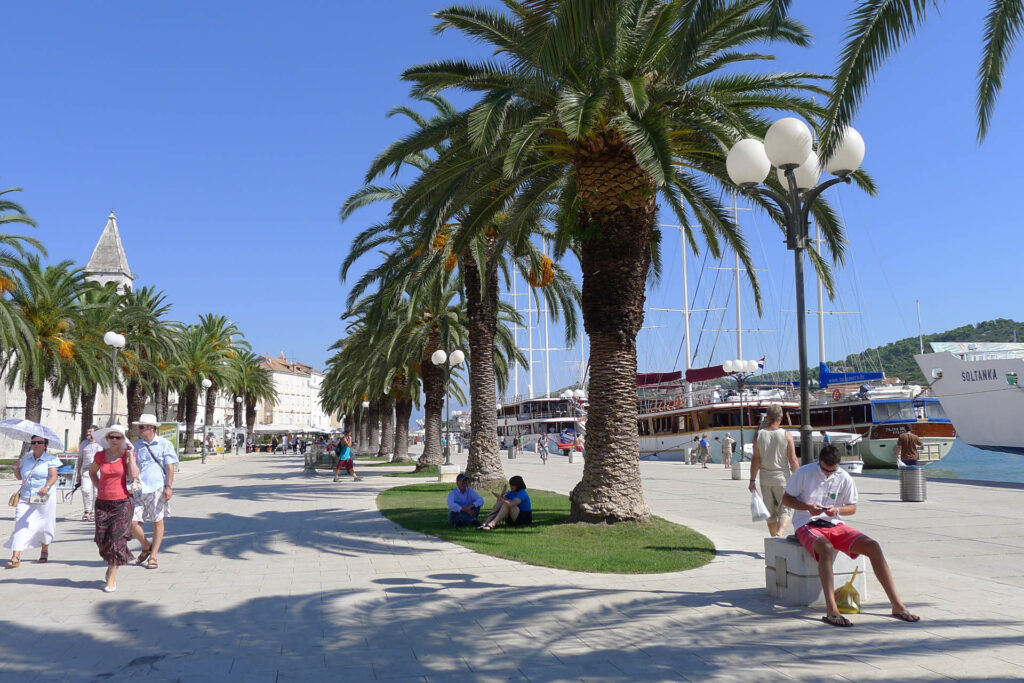
Bustling Marketplace: At certain times, the Riva transforms into a bustling marketplace, especially during events and festivals. Local artisans showcase their crafts, and the air is filled with the lively energy of cultural celebrations.
Sunset Views: The Riva is particularly magical during sunset when the sky is painted with warm hues. Finding a waterfront spot to witness the sun dipping below the horizon is a must.
Whether one seeks a leisurely stroll, a taste of local cuisine, or simply the pleasure of being by the sea, the Riva is a place where the charm of town converges with the beauty of the Adriatic.
8. The Cipiko Palace
The Cipiko Palace, a splendid architectural gem nestled within the historic core of Trogir, stands as a testament to the town’s rich cultural and artistic heritage. Dating back to the 15th century, this well-preserved palace is an emblem of medieval prosperity and the prominent role played by the Cipiko family in shaping city’s history.
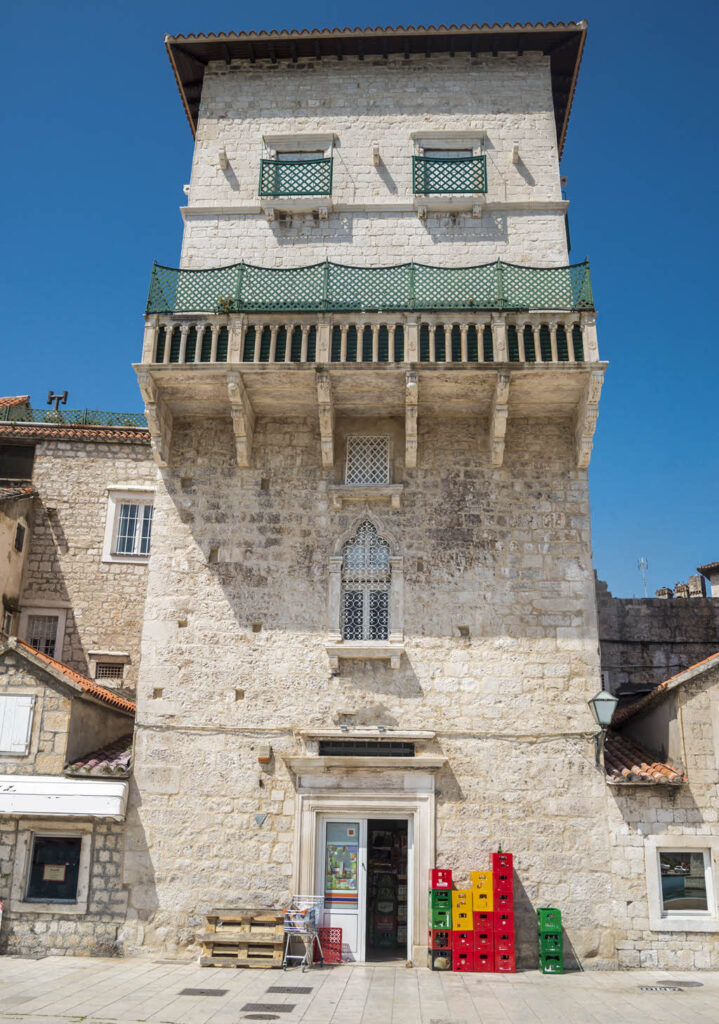
Historical Significance: Originally commissioned by the Cipiko family, a prominent noble lineage in medieval Trogir, the palace served as both a residence and a symbol of the family’s influence. It stands as a tangible link to the town’s political and economic prominence during this period.
Renaissance Architecture: The Cipiko Palace showcases exemplary Renaissance architecture, characterized by harmonious proportions, decorative elements, and a meticulous attention to detail. The façade is adorned with intricately carved stone reliefs, reflecting the artistic sensibilities of the time.
Courtyard and Loggia: The palace features a charming inner courtyard, an oasis of tranquility adorned with elements of classical design. A notable highlight is the Loggia, an open-sided gallery with arches that overlooks the courtyard, providing an elegant space for gatherings.
9. Old Fish Market
Preserving the echoes of centuries past, the Old Fish Market in Trogir emerges as a venerable testament to the town’s maritime heritage. Constructed in the 16th century, this historic edifice not only stands as a witness to the ebb and flow of time but also embodies the resilience of Trogir’s coastal community.
Maritime Marketplace: Since its inception, the Old Fish Market has been a bustling hub of maritime commerce. Local fishermen, clad in the attire of centuries past, once converged here to trade their daily catches, creating a vibrant marketplace that fueled the town’s sustenance and economic vitality.
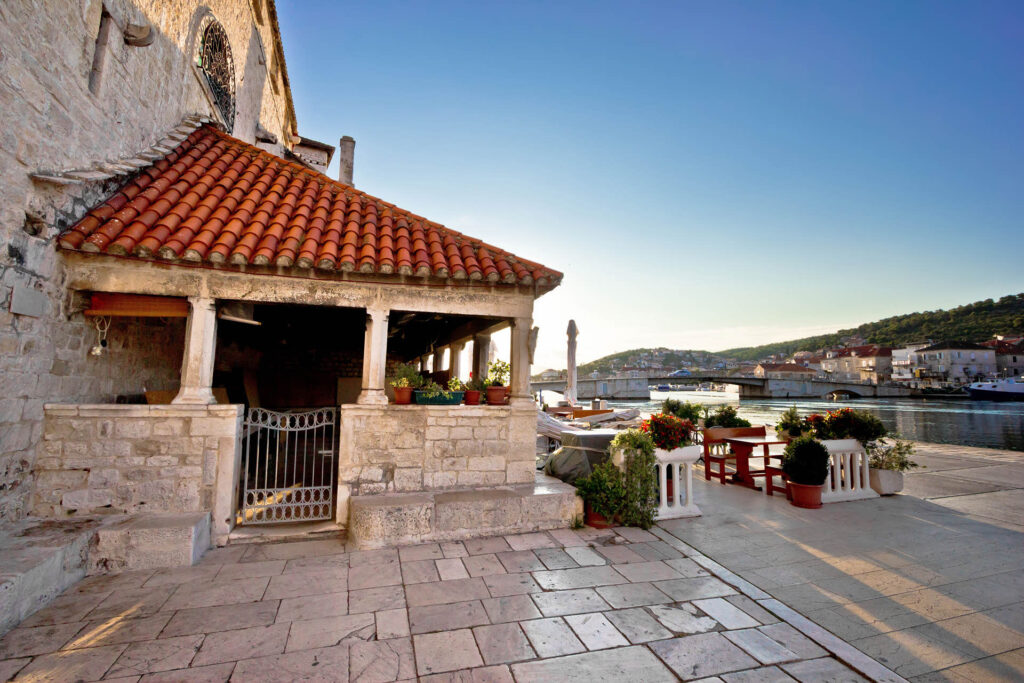
10. Navigating Trogir’s Enchanting Downtown: A Stroll Through Narrow Streets
Trogir’s downtown beckons visitors with a mesmerizing journey through narrow, cobblestone streets that weave a tapestry of history and charm. Dating back to ancient times and adorned with architectural wonders, this labyrinthine network of alleys immerses you in the essence of Trogir’s rich cultural heritage.

Medieval Architectural Splendor: Trogir’s downtown is a living museum of medieval architecture, showcasing well-preserved buildings, intricate facades, and atmospheric squares. Each narrow street unfolds a visual feast, inviting exploration of structures dating from various historical periods.
Historical Landmarks: The labyrinth of narrow streets leads to Trogir’s most iconic landmarks, including the Cathedral of St. Lawrence, the Cipiko Palace, and the Kamerlengo Fortress. These architectural gems stand as testament to the town’s significance throughout the centuries.
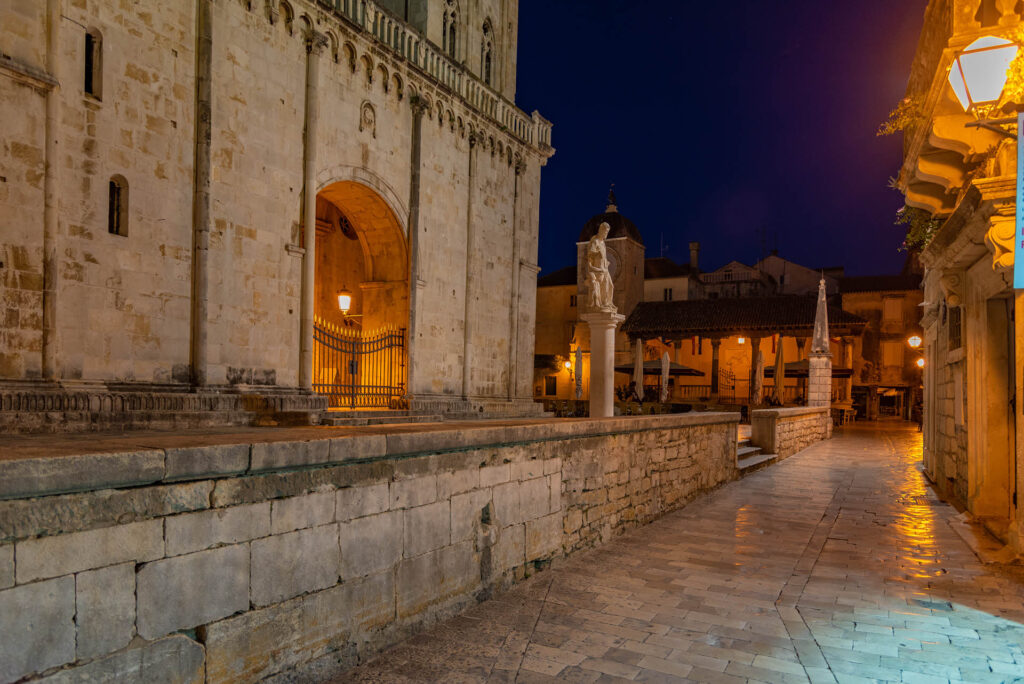
Artisan Boutiques and Cafés: The narrow streets are lined with artisan boutiques, quaint shops, charming cafés and restaurants. Explore these hidden corners to discover local craftsmanship, unique souvenirs, and cozy spots to savor a cup of coffee while soaking in the ambiance.
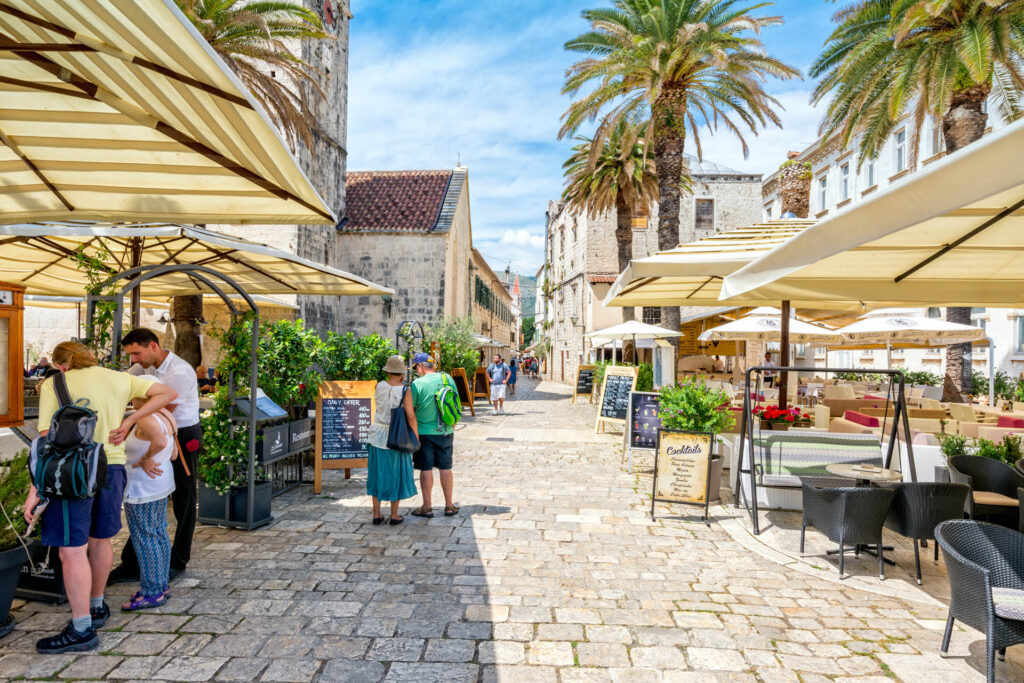
Local Life Unveiled: Navigating the narrow streets offers glimpses into local life. Witness residents going about their daily routines, hanging laundry across balconies, and engaging in animated conversations. The intimate setting provides an authentic experience of Trogir’s community. As you meander through the labyrinthine alleys, adorned with time-worn cobblestones and historic facades, you’ll witness residents engaged in daily routines, exchanging friendly greetings, and adding a touch of authenticity to the town’s bustling atmosphere. These narrow thoroughfares act as conduits to the soul of city, where the rhythm of everyday life unfolds amidst the architectural wonders, creating an immersive experience that goes beyond mere sightseeing.
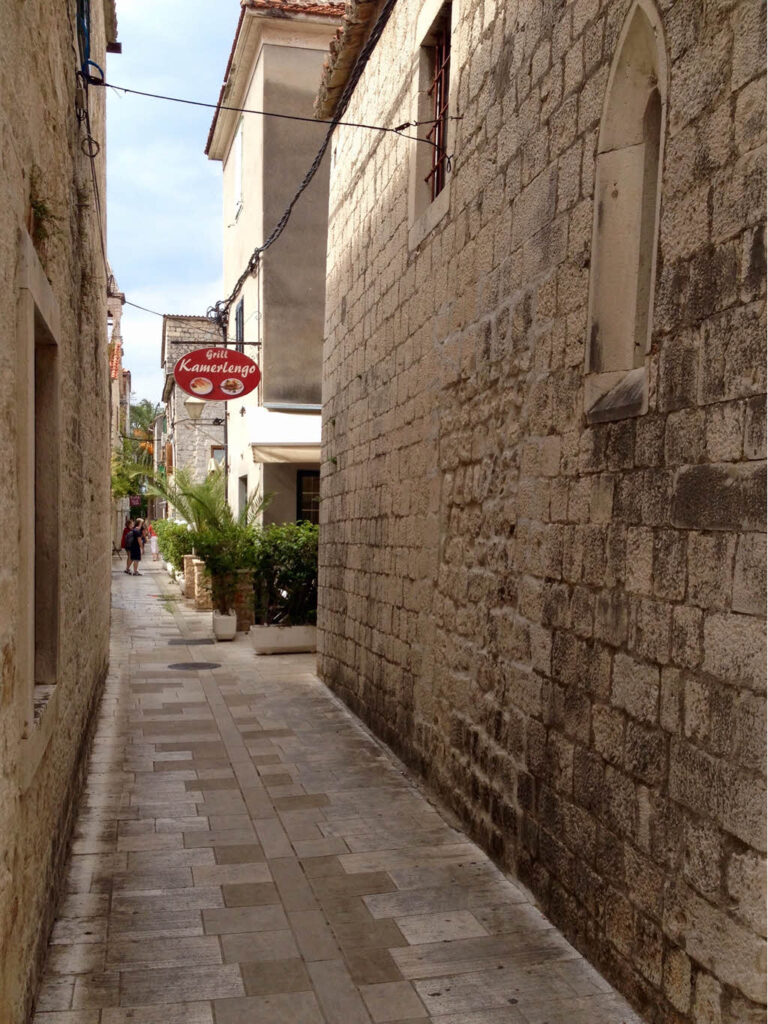
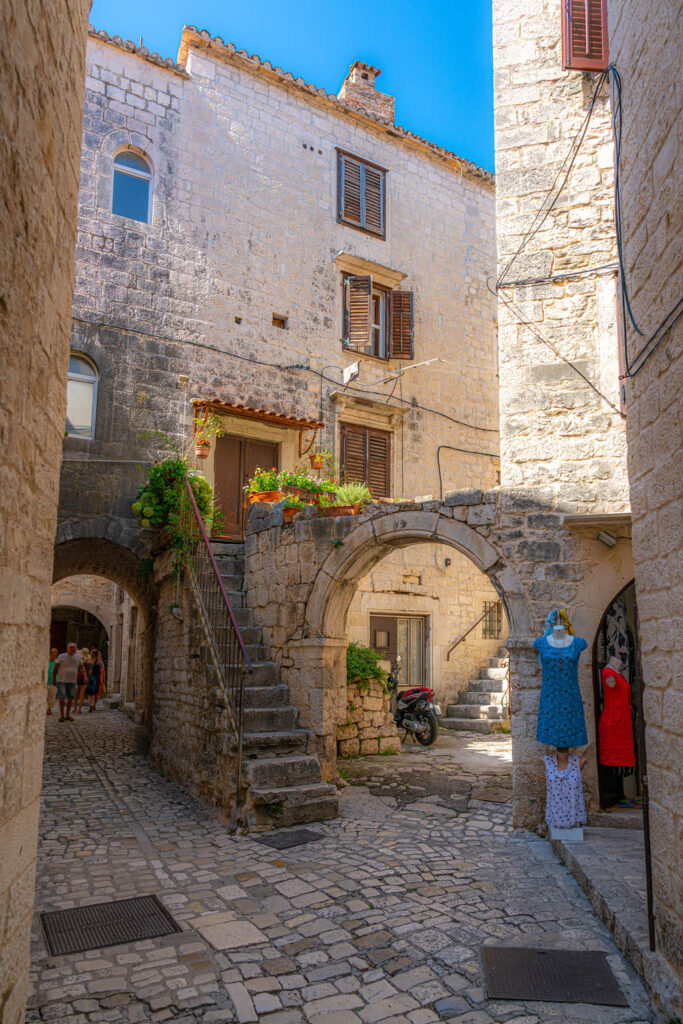
Charming Alleys and Passageways: Embrace the spontaneity of exploration. Allow yourself to wander through the narrow streets, get lost in their maze-like charm, and discover unexpected delights around each corner. Have fun in the labyrinthine network of narrow alleys that wind their way through the historic center. Each turn unveils hidden squares, quaint courtyards, and glimpses of local life.
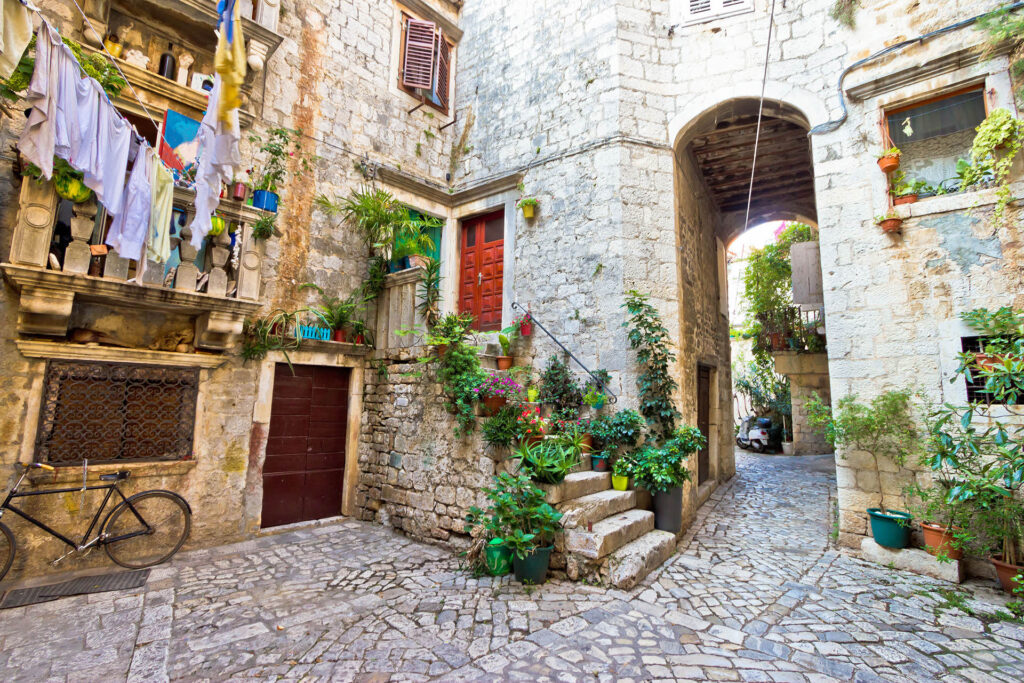
The downtown, with its narrow streets, encapsulates the spirit of a living, breathing historical canvas. As you traverse these alleys, each step becomes a journey through time, offering a profound connection to the town’s enduring legacy.
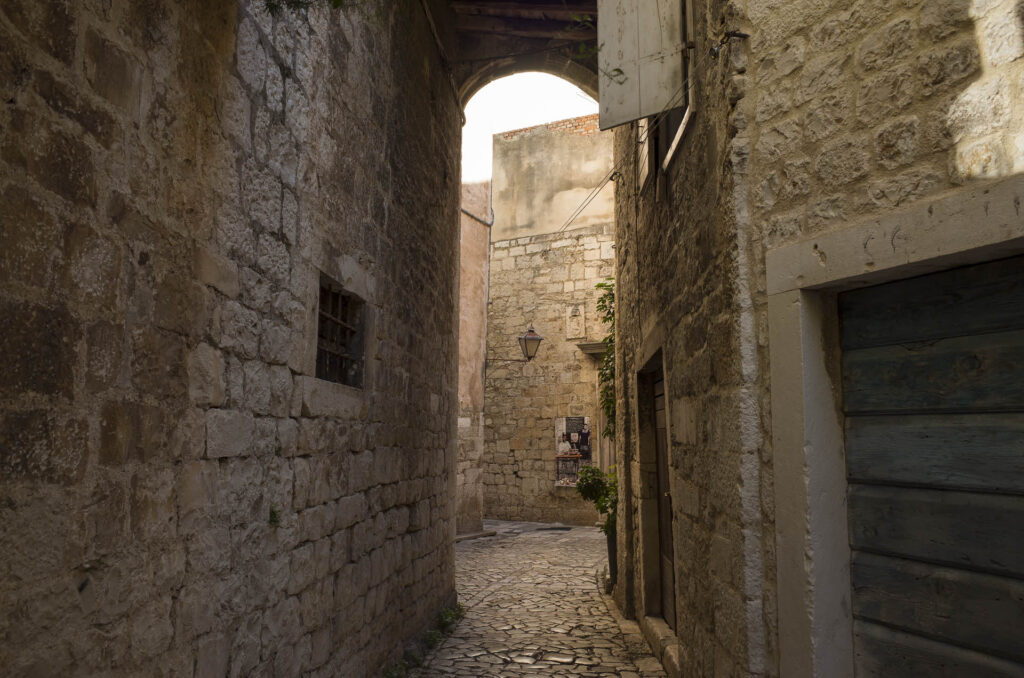
Photographic Opportunities:
Architectural Details: Capture the intricate details of medieval doorways, window shutters, and wrought-iron balconies that adorn the narrow streets.
Street Scenes: Document the vibrant street scenes—locals chatting in alleyways, children playing, and the play of light and shadow creating a cinematic backdrop.
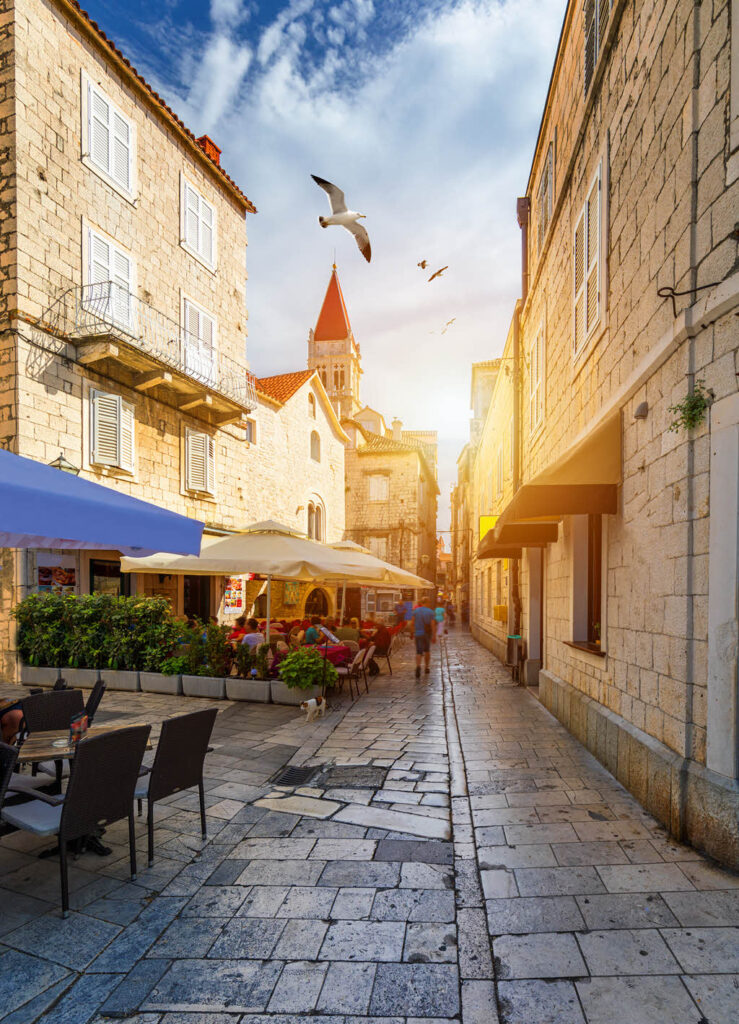

The historic center of Trogir is more than a collection of buildings; it’s a living testament to the resilience and vibrancy of a town that has withstood the test of time. Whether you’re a history enthusiast, an architecture lover, or someone seeking the authentic view of Croatia, town’s historic center promises an enchanting experience that transcends eras.
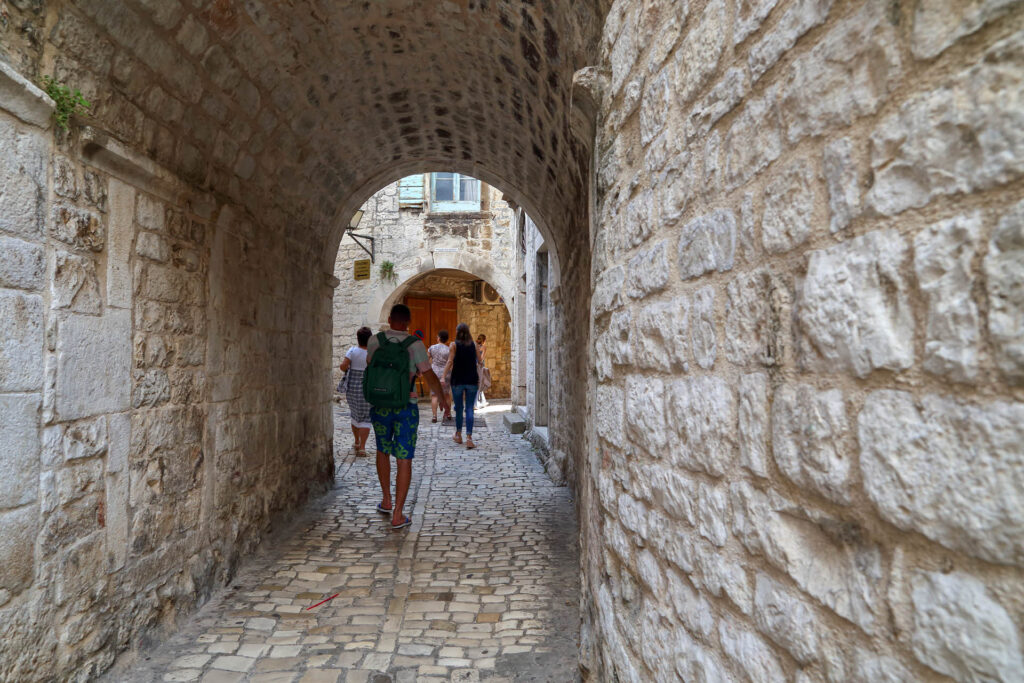
11. Duke Palace
The “Knežev dvor” or the “Duke Palace” served as the municipality building in Trogir, where the duke, chosen from the ranks of the Venetian nobility, governed the town. The duke and their family resided in the municipality’s chambers during the Venetian rule. Hence, the name “Duke Palace” for this edifice. Until the year 1848, only nobles had the right to enter the municipality.
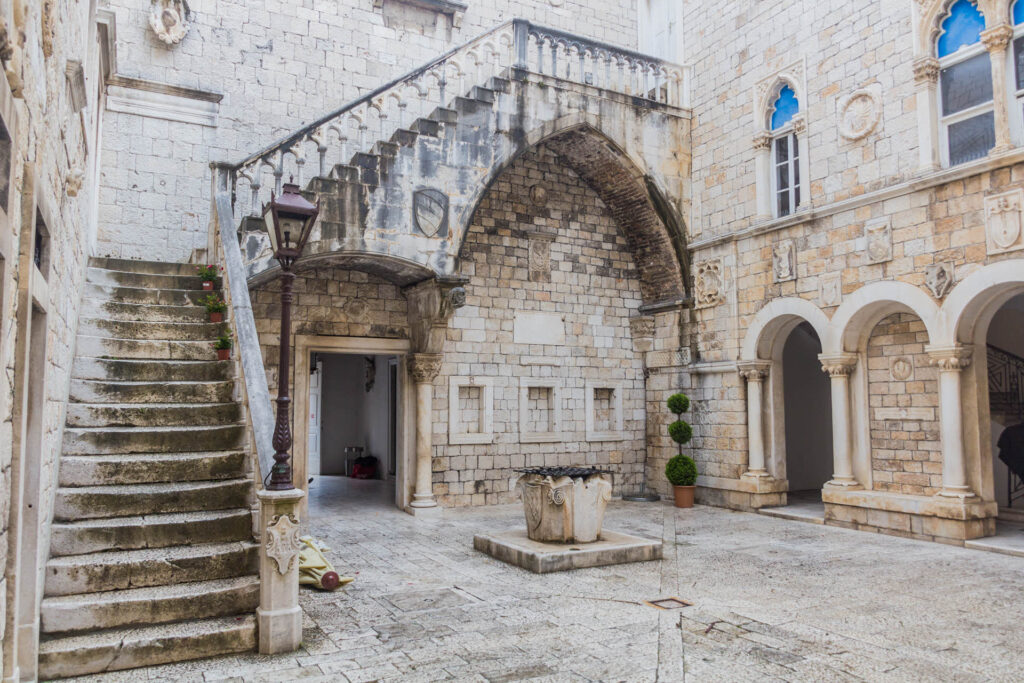
12. Small Bridges Linking Trogir to Mainland and Čiovo
Trogir, ensconced on a small island between the mainland and the larger Čiovo island, is a town seamlessly connected by two bridges that not only traverse physical waters but also span centuries of history. These bridges serve as iconic symbols, linking the past to the present and providing gateways to the diverse facets of town’s cultural tapestry.
The walkable bridges, connecting the Trogir’s island to the mainland and to Čiovo island, are both less than 100 meters in length, with the bridge to the mainland being around 35 meters in length. Both bridges are easily accessible on foot from either side of the road. The stone bridge to Čiovo Island, constructed in the 19th century, replaced an earlier wooden bridge.
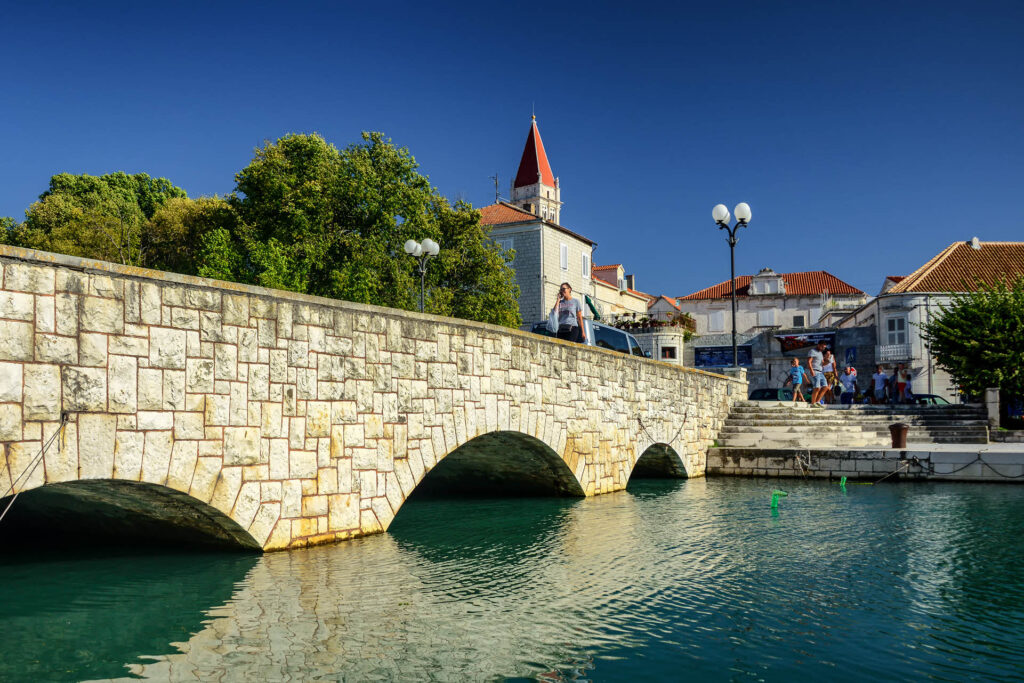
Stroll Along the Bridges: Take a leisurely walk along the Trogir Bridge and smaller bridges, absorbing the blend of modernity and history. Capture the play of light on the water and the reflections that dance beneath the arches.
Bridging Time and Culture: The two bridges of Trogir not only physically connect disparate parts of the town but also bridge time, offering a journey through the centuries. Each bridge narrates a chapter of town’s story, from its medieval roots to its present-day vibrancy.
Newly built Trogir Bridge (Bridge Dr. Franjo Tuđman): As the primary link connecting the mainland to Čiovo Island, this modern structure serves as a vital thoroughfare for both vehicles and pedestrians, offering panoramic views of Trogir’s skyline. Completed in July 2020, the 551-meter-long bridge plays a crucial role in alleviating traffic congestion in city’s downtown. Its construction, along with the integration of roads on Čiovo, has significantly contributed to reducing the number of cars circulating within the historic core of Trogir.
13. Exploring Trogir’s Culinary Scene: A Diverse Array of Restaurants and Cafés
Culinary scene in town is a vibrant mosaic that mirrors the town’s rich history and cultural diversity.
Mediterranean Flavors: Trogir’s restaurants artfully showcase the essence of Mediterranean cuisine. From freshly caught seafood to locally sourced olive oil, herbs, and vegetables, each dish reflects the region’s sun-kissed terroir.
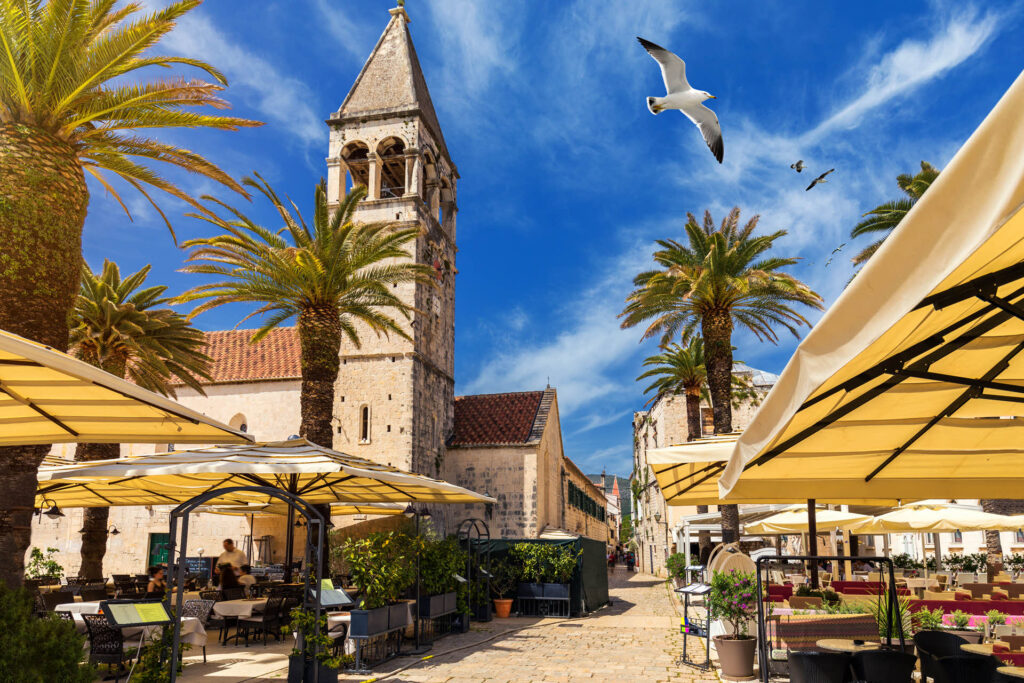
Historic Ambiance: Dining in Trogir often unfolds in historical settings, with restaurants occupying centuries-old buildings, charming squares, and waterfront locales. The ambiance itself becomes a part of the culinary experience, transporting diners to eras gone by.
Seafood Extravaganza: As a coastal town, Trogir takes pride in its seafood offerings. Local specialties like black risotto, grilled fish, and octopus peka tantalize taste buds, inviting diners to indulge in the bounties of the Adriatic Sea.
Traditional Dalmatian Delights: Town’s culinary repertoire includes a showcase of Dalmatian specialties. Peka dishes slow-cooked under an iron bell, pasticada (marinated beef), and various peka-roasted meats offer a savory dive into the region’s gastronomic heritage.

Croatian Coffee Culture: City’s cafés embrace the Croatian coffee culture, inviting patrons to linger over strong espresso or savor the ritual of a leisurely cup of Turkish coffee. Café terraces offer perfect vantage points for people-watching in the town’s lively squares.
Wine and Olive Oil: Trogir’s proximity to Croatia’s wine regions ensures a diverse selection of local wines available in restaurants and cafés. Trogir’s olive groves contribute to the production of exceptional olive oil. Visitors can explore the nuances of local olive oils, often accompanied by artisanal bread and Dalmatian prosciutto.
Navigating Trogir’s Culinary Landscape: Embarking on a culinary adventure in Trogir involves exploring both hidden gems and renowned establishments. Whether dining in a historic konoba, a seaside restaurant, or a cozy café, each culinary encounter in town is a celebration of the town’s gastronomic diversity and the warmth of its hospitality.
14. Take a Boat Tour from Trogir
Trogir, adorned with its medieval charm, stands not only as a captivating destination but also as the main embarkation point for enchanting boat tours exploring the nearby Adriatic islands. These boat excursions, departing from Trogir’s waterfront, unveil a maritime tapestry of crystal-clear waters, historic isles, and coastal wonders.
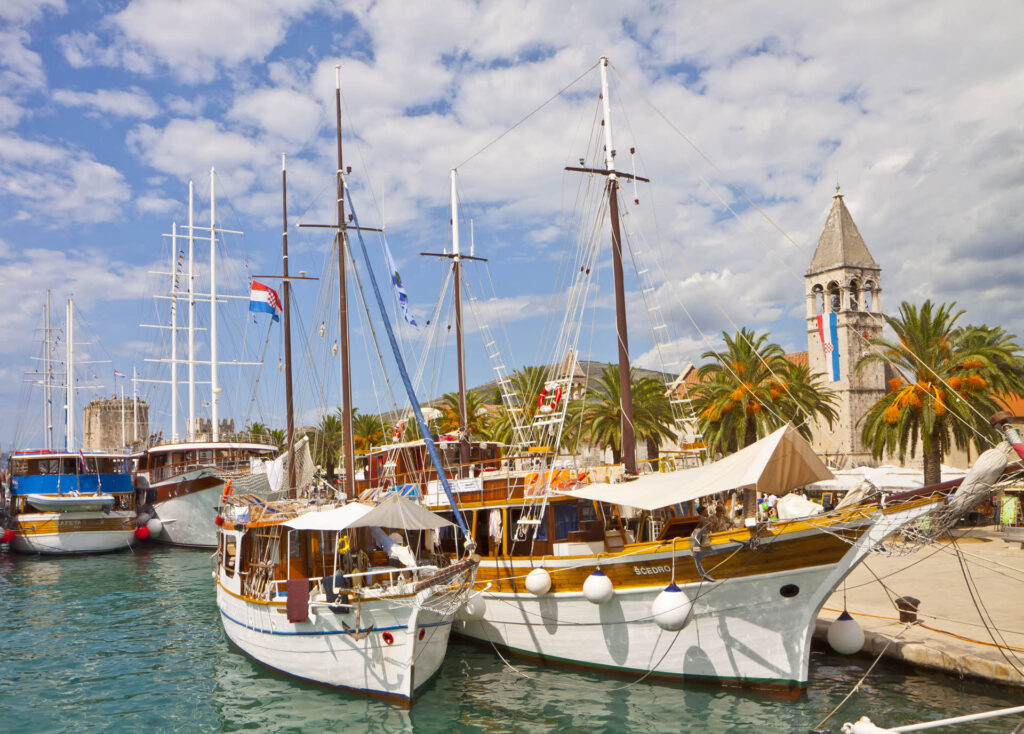
Island Hopping Delights: Trogir serves as the gateway to a myriad of nearby islands, each with its own allure. From the sun-kissed beaches of Brač and Šolta islands to the historic richness of Hvar town, boat tours offer a chance to explore diverse landscapes and cultural treasures.
Blue Lagoon Exploration: Set sail to the mesmerizing Blue Lagoon, a shimmering turquoise oasis framed by islets and coral reefs. Snorkel in the pristine waters, bask in the Mediterranean sun, and relish the tranquility of this idyllic natural wonder.
Booking Options: Numerous boat tour operators offer a variety of excursions catering to different preferences. Choose from full-day island-hopping adventures, sunset cruises, or personalized private tours.
Snorkeling Gear: If your boat tour includes stops at snorkeling hotspots like the Blue Lagoon, consider bringing your snorkeling gear to fully experience the vibrant underwater world.
Local Insights: Engage with local boat captains and guides who often share fascinating anecdotes about the history, folklore, and marine life of the Adriatic region.
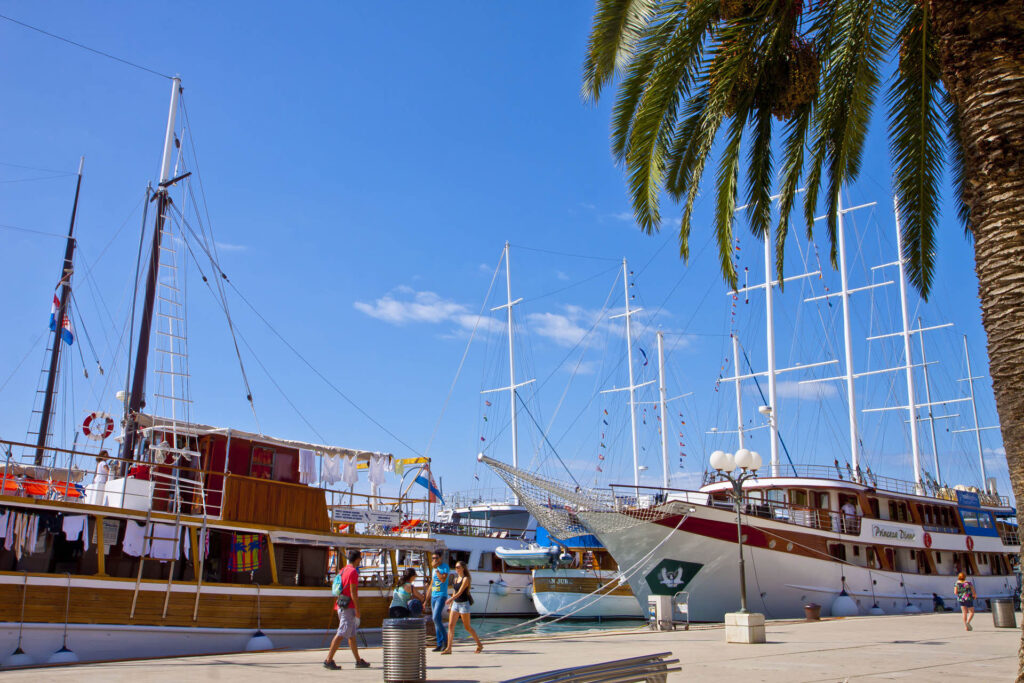
Savoring the Adriatic Breeze: Embarking on a boat tour from Trogir isn’t just a journey; it’s an immersive experience in the Adriatic’s coastal splendor. Whether you’re seeking relaxation on hidden beaches, exploring historic gems, or savoring the thrill of island hopping, these boat tours transform the shimmering sea into a canvas of unforgettable adventures.








